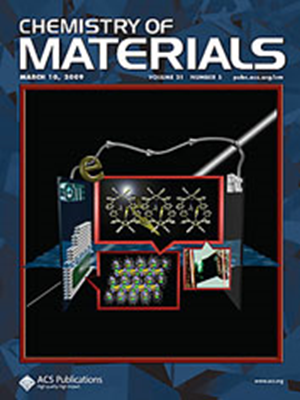KNbO3钙钛矿增强锂存储的a位空位工程
IF 7
2区 材料科学
Q2 CHEMISTRY, PHYSICAL
引用次数: 0
摘要
使用创新方法设计定制材料,使充电/放电过程更快,可能是改善电动汽车移动性的关键。在这项工作中,开发了一种修改KNbO3钙钛矿结构的策略,通过在结构的a位用La3+部分取代K+,在晶格中每次取代产生两个阳离子空位。通式K1-3xLax□2xNbO3(0≤x≤0.15;□为a位空位)已通过溶胶-凝胶法合成。随着La取代和结构中人工空位的产生,KNbO3被激活以插入Li+。高取代的K0.55La0.15□0.30NbO3(30%原子A位空位)在0.05-3.0 V vs Li+/Li电位窗口中,在0.02 A g-1下表现为164 mAh g-1。非原位7Li和93Nb MAS NMR分别证实了与空位相关的Li+插入增加以及Nb5+局部环境的相应变化。原位x射线衍射(XRD)分析揭示了高取代材料在Li+插入后的固溶型存储机制,其最大体积变化仅为1.3%。这就是在0.1 A·g-1下循环900次后获得显著容量保持的原因。与插入材料的经典设计不同,本研究提出了一种在不牺牲原始相的情况下产生空位的替代方法,有可能使用不太常见的abo3型钙钛矿作为电池电极。本文章由计算机程序翻译,如有差异,请以英文原文为准。

A-Site Vacancy Engineering in KNbO3 Perovskite for Enhanced Lithium Storage
Design of tailored materials using innovative approaches that allow faster charging/discharging processes could be the key for improvement of electric mobility. In this work, a strategy is developed to modify KNbO3 perovskite structure by partially substituting K+ with La3+ at the A-site of the structure, creating two cation vacancies per substitution in the lattice. Materials with the general formula K1–3xLax□2xNbO3 (with 0 ≤ x ≤ 0.15; □ is an A-site vacancy) have been synthesized by the sol–gel method. With La substitution and creation of artificial vacancies in the structure, KNbO3 became activated for Li+ insertion. The highly substituted K0.55La0.15□0.30NbO3 (30% atomic A-site vacancies) exhibited 164 mAh g–1 at 0.02 A g–1 in the 0.05–3.0 V vs Li+/Li potential window. Ex situ 7Li and 93Nb MAS NMR confirmed an increased Li+ insertion in relation to vacancies and corresponding changes in Nb5+ local environment, respectively. In situ X-ray diffraction (XRD) analysis revealed a solid-solution-type storage mechanism with a maximum volume change of only 1.3% upon Li+ insertion for highly substituted material. This accounts for the remarkable capacity retention obtained after 900 cycles at 0.1 A·g–1. Diverged from the classical design of insertion materials, this study presents an alternative approach of creating vacancies without sacrificing the pristine phase, with a possibility to use the not so common class of ABO3-type perovskites as the battery electrode.
求助全文
通过发布文献求助,成功后即可免费获取论文全文。
去求助
来源期刊

Chemistry of Materials
工程技术-材料科学:综合
CiteScore
14.10
自引率
5.80%
发文量
929
审稿时长
1.5 months
期刊介绍:
The journal Chemistry of Materials focuses on publishing original research at the intersection of materials science and chemistry. The studies published in the journal involve chemistry as a prominent component and explore topics such as the design, synthesis, characterization, processing, understanding, and application of functional or potentially functional materials. The journal covers various areas of interest, including inorganic and organic solid-state chemistry, nanomaterials, biomaterials, thin films and polymers, and composite/hybrid materials. The journal particularly seeks papers that highlight the creation or development of innovative materials with novel optical, electrical, magnetic, catalytic, or mechanical properties. It is essential that manuscripts on these topics have a primary focus on the chemistry of materials and represent a significant advancement compared to prior research. Before external reviews are sought, submitted manuscripts undergo a review process by a minimum of two editors to ensure their appropriateness for the journal and the presence of sufficient evidence of a significant advance that will be of broad interest to the materials chemistry community.
 求助内容:
求助内容: 应助结果提醒方式:
应助结果提醒方式:


